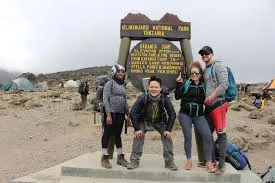Kilimanjaro Weather Guide: What to Expect on the Mountain
Mount Kilimanjaro’s weather is as diverse as its landscapes, ranging from warm, humid rainforests to freezing arctic conditions at the summit. Understanding these patterns is crucial for a safe and enjoyable climb. This comprehensive guide by Capable Africa Tours covers temperature ranges, rainfall, seasonal variations, and packing tips to prepare you for a 6–9 day trek to Uhuru Peak.
Plan Your Kilimanjaro Trek Now
Understanding Mount Kilimanjaro’s Weather Patterns
Mount Kilimanjaro, Africa’s highest peak at 5,895 meters (19,341 feet), features five distinct ecological zones, each with unique weather conditions. From the lush rainforest at the base to the arctic summit, temperatures can vary dramatically within a single day. This guide by Capable Africa Tours provides both qualitative insights and quantitative data to help you prepare for your climb.
Kilimanjaro’s Climate Zones
- Cultivation Zone (800–1,800m): Warm and humid (70–80°F), with frequent rainfall (40–60 inches annually).
- Rainforest Zone (1,800–2,800m): Hot, wet conditions (65–75°F), heavy rainfall (up to 80 inches/year).
- Heath/Moorland Zone (2,800–4,000m): Cooler temperatures (50–60°F), misty with occasional rain (20–40 inches/year).
- Alpine Desert Zone (4,000–5,000m): Cold, dry air (30–50°F daytime, 20–30°F nights), minimal precipitation.
- Arctic Summit Zone (5,000–5,895m): Freezing conditions (0–20°F), high winds (up to 40 mph), and possible snow.
Seasonal Weather Variations
Kilimanjaro has two main climbing seasons and two wet seasons, influencing trek planning:
| Season | Months | Weather | Pros | Cons |
|---|---|---|---|---|
| Dry Season (Main) | January–March, June–October | Clear skies, minimal rain, 50–80°F (lower zones), 0–20°F (summit) | Best visibility, safer summit conditions, high success rates (up to 98% with Capable Africa Tours) | Crowded trails, higher costs |
| Wet Season (Short) | November–December | Light rain, 60–75°F (lower zones), occasional summit snow | Fewer crowds, lush scenery | Unpredictable rain, muddy trails |
| Wet Season (Long) | April–May | Heavy rain (5–10 inches/month), 55–70°F (lower zones) | Low crowds, cheaper rates | High rain, low summit success (60–70%) |
Why Weather Matters for Your Kilimanjaro Climb
Weather significantly impacts your safety, comfort, and summit success on Kilimanjaro. Proper preparation for temperature swings, rain, and wind ensures a smoother trek. Capable Africa Tours emphasizes understanding these conditions to pack appropriately and choose the right season. Here’s why weather awareness is critical:
- Safety: Cold summit temperatures and high winds increase hypothermia risks without proper gear.
- Comfort: Waterproof clothing and layered systems keep you dry and warm in varying conditions.
- Success Rate: Dry seasons offer clearer paths and better summit conditions, boosting success rates to 98% with guided tours.
- Visibility: Clear skies in dry months enhance views of Kilimanjaro’s landscapes, from rainforests to glaciers.
Weather Data for Kilimanjaro
Below is a detailed breakdown of average temperatures and precipitation across Kilimanjaro’s zones, based on historical data, to help you plan your trek with Capable Africa Tours.
| Zone | Altitude (m) | Avg. Day Temp (°F) | Avg. Night Temp (°F) | Annual Rainfall (inches) |
|---|---|---|---|---|
| Cultivation | 800–1,800 | 70–80 | 55–65 | 40–60 |
| Rainforest | 1,800–2,800 | 65–75 | 50–60 | 60–80 |
| Heath/Moorland | 2,800–4,000 | 50–60 | 40–50 | 20–40 |
| Alpine Desert | 4,000–5,000 | 30–50 | 20–30 | 5–10 |
| Arctic Summit | 5,000–5,895 | 0–20 | -10–10 | 2–5 |
Packing for Kilimanjaro’s Weather
Effective packing mitigates Kilimanjaro’s unpredictable weather. Capable Africa Tours recommends a layered clothing system and weather-specific gear to handle rain, cold, and UV exposure. Below are tailored packing tips:
Clothing Recommendations
- Base Layers: 3–4 moisture-wicking shirts and pants (merino wool, 200g) for sweat management.
- Mid-Layers: 2 fleece jackets (300–400g) for insulation in cooler zones.
- Outer Layers: Waterproof, windproof jacket and pants (Gore-Tex) for rain and summit winds.
- Thermal Gear: 800-fill down jacket and thermal underwear for summit night (0–20°F).
- Accessories: Wool socks (2–3 pairs), waterproof hiking boots, gaiters, gloves, and a warm hat.
- Sun Protection: UV400 sunglasses, SPF 50+ sunscreen, lip balm, and a wide-brimmed hat.
Gear for Weather Conditions
- Daypack (30–40L): Carry rain covers and extra layers for sudden weather shifts.
- Sleeping Bag: Rated for -15°C/5°F with a sleeping pad (R-value 4+).
- Trekking Poles: Lightweight (500–700g) for stability on wet or icy terrain.
- Water System: 3L hydration bladder or 2 1L bottles to stay hydrated in dry zones.
Visualize Kilimanjaro’s Weather Challenges
Explore Mount Kilimanjaro’s diverse climate zones with Capable Africa Tours. Watch this video to understand weather patterns and prepare for your trek.
Ready to Conquer Kilimanjaro?
Prepare for Mount Kilimanjaro’s weather with Capable Africa Tours. Our expert guides and tailored itineraries ensure a safe, memorable climb to Uhuru Peak.
- 98% summit success rate with experienced guides
- Weather-informed route planning for safety
- Gear rentals for rain and cold conditions
- Eco-friendly treks supporting local communities
- All-inclusive packages with meals and transfers
Limited spots for dry season treks — book now to secure your adventure!
Plan Your Trek Now


